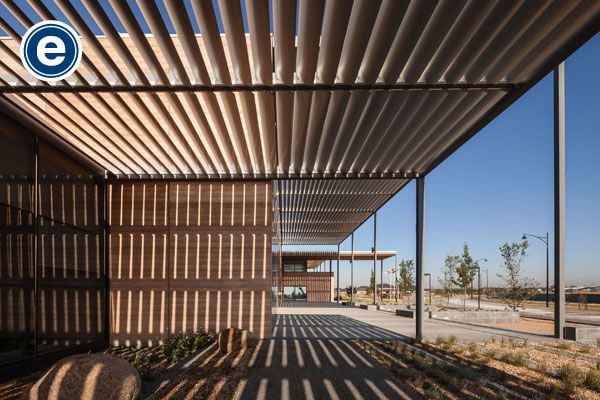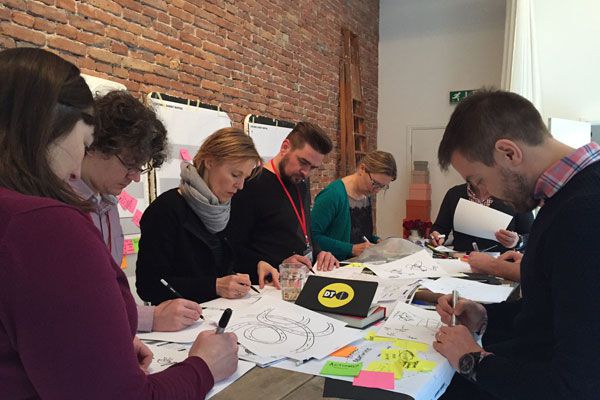The Hume Global Learning Centre challenges any preconceived notions you might have had about the architectural typography a library can take; which is why it was awarded the International Global Library of the Year 2014. We grab our book bags and take a look around.

March 18th, 2015
The first thing you notice about the Hume Global Learning Centre – or Craigieburn Library as it is better known – is that it is quite unlike any library building you’ve ever seen before. The building is conceived as a series of interlocking pavilions of varying height and scale that step down from the entrance and a two-storey, central library reading space to the low scale of the children’s library.
Architects Francis-Jones Morehen Thorp (FJMT) conceived the project to become a built focus of public life for the Hume community north of Melbourne, but also sought to connect the architecture with the natural landscape that is rapidly being transformed by residential expansion. FJMT utilised heavy rammed earth walls to form the enclosure and unite the building with the earth it sits upon. They also extended each pavilion into the landscape through louvered roofs that create a series of northern verandahs.
The cruciform circulation through the building ties these functions together in a highly legible, simple geometry. The primary reading room consists of double-height volume with excellent access to natural light, with reading areas positioned along the glazed northern façade, protected by high-level, directional roof louvers.
In addition to the core library services, the project includes an integrated local art gallery, café, childcare centre, computer training centre and meeting and function spaces. And the louvered verandahs have quickly become a focal point for community activities such as markets and musical performances.
The prestigious International Public library of the Year Award for 2014 was bestowed at the annual IFLA (International Federation of Library Associations and Institutions) in Lyon France. The judges justified their decision on the basis that Craigieburn “distinguishes itself as a significant modern construction with a strong, recognisable architectural concept and is a good example of how the City of Hume has used a library to create a sense of belonging for all demographic groups as a both a learning centre and a gathering place for the city.”
Photography by Trevor Mein
Francis-Jones Morehen Thorp
fjmt.com.au
INDESIGN is on instagram
Follow @indesignlive
A searchable and comprehensive guide for specifying leading products and their suppliers
Keep up to date with the latest and greatest from our industry BFF's!

A longstanding partnership turns a historic city into a hub for emerging talent

Gaggenau’s understated appliance fuses a carefully calibrated aesthetic of deliberate subtraction with an intuitive dynamism of culinary fluidity, unveiling a delightfully unrestricted spectrum of high-performing creativity.

In this candid interview, the culinary mastermind behind Singapore’s Nouri and Appetite talks about food as an act of human connection that transcends borders and accolades, the crucial role of technology in preserving its unifying power, and finding a kindred spirit in Gaggenau’s reverence for tradition and relentless pursuit of innovation.

It’s widely accepted that nature – the original, most accomplished design blueprint – cannot be improved upon. But the exclusive Crypton Leather range proves that it can undoubtedly be enhanced, augmented and extended, signalling a new era of limitless organic materiality.

Grace Turtle, MashUp’s Customer Experience Designer, has had a busy start to the year. She attended a DesignThinkers Bootcamp in Amsterdam, spoke at Link Festival in Melbourne and also at The Future Laboratory’s Sydney Trends Briefing.
The internet never sleeps! Here's the stuff you might have missed

The founder and managing director of iconic Australian furniture brand Cult joins us on the podcast to discuss his journey through the world of commercial design.

The Finding Infinity Principal comments here on the question of balance in city life, with architecture and design highlighted as the key levers for making change.

While the alluring myth of a lone genius can be particularly appealing, Knoll’s enduring legacy was built on a more profound reality: that a singular vision is only augmented through dialogue, proving that collaboration is one of the most transformative tools in design.